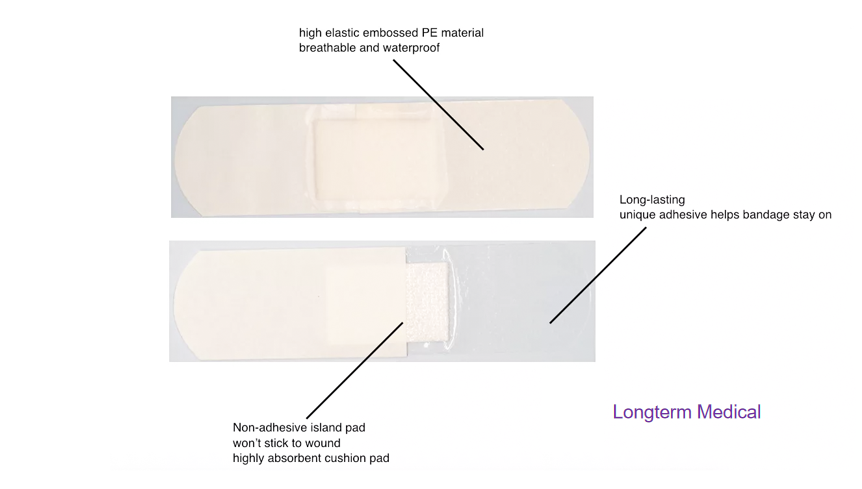Little Band-Aid, are you using it right?
I still remember when I was a child, as long as there was a bump, the adults in the family would use the Band-Aid to stick it, but sometimes the Band-Aid is not a panacea; it can only be used on the wound with the very superficial epidermis, and it is not easy to be infected! I remember a time when I ran a competition with my little friend, but I fell during the run, and my knee was scratched a lot by the glass. Now, the lessons of blood and tears are painful to the point of leaving childhood shadows... But do you really use Band-Aids? Maybe everyone used Band-Aids wrong before. When can Band-Aids be used, and when can they not be used?
When to use a Band-Aid:
Band-aids should only be used if there is no active bleeding, the wound is tiny and does not require surgical sutures, and there is no infection.
How should Longterm Medical Band-Aids be used for different wounds?
In life, accidental injuries and skin lesions such as scratches, scratches, and cuts are also common. Wounds vary in size and severity and therefore are treated differently. If there is only a scratch on the epidermis, the scratch area is small, and the amount of bleeding is not large, you can use the traditional band aid: it is mainly composed of adhesive tape and an absorbent pad which can temporarily dry the wound. Suppose you want the wound to heal faster, reduce infection, and be waterproof. In that case, it is recommended to use Hydrocolloid band aid: it can prevent the invasion of external bacteria, and it is also conducive to wet healing on the wound. 
Not all wounds can use a Band-Aid:
Band-Aids cannot be used in the following situations:
1. The wound surface is large. The length of the wound should not exceed the width of the Band-Aid. If the wound is large, it should go to the hospital for disinfection, debridement, suture, and bandage.
2. The wound surface is not clean. If the wound surface is not clean and the wound surface is covered with a Band-Aid, it will cause infection, so the wound should be cleaned and disinfected first.
3. Deep and little wounds. Such as the wound caused by the nail accidentally injuring the finger; if a Band-Aid is attached to it, it is easy to cause infection. In particular, anaerobic infections such as tetanus bacillus. Such wounds should be exposed after hemostasis, and a tetanus shot should be administered.
4. Bitten by pets. Such wounds should be washed with soapy water for 10 to 15 minutes and then disinfected with iodine and medical alcohol to expose the wounds and inject vaccines as soon as possible.
5. Ulceration and running water appear after scalding. At this time, sticking a Band-Aid on the wound will cause poor drainage of secretions and aggravate the infection.
6. There is a foreign body in the wound. The poor water absorption and air permeability of the band-aid are not conducive to the absorption and drainage of secretions, but it is conducive to the growth and reproduction of bacteria and aggravates the disease.
If the wound is huge and deep, in addition to debridement, it is best to bandage the wound with clean and hygienic gauze and go to the hospital in time for more professional and complete debridement, disinfection, suture bandage, and injection of tetanus antitoxin to avoid further Infection with bacteria and tetanus bacteria.
How to use Band-Aid correctly?
Before sticking the Band - Aid, prepare for debridement and disinfection: make sure that the wound is free of dust and other dirt, wash the wound with water or normal saline (0.9% sodium chloride solution), then use iodophor for disinfection, and wipe it in a circular motion. It can be 3 to 5 cm around the wound. It should be noted that alcohol is not suitable for washing damaged wounds. The Band -Aid should be changed at least once a day, and it should be replaced in time if it gets wet or dirty. In the case of hot and humid summer, you must not cover the wound for a long time. Usually, when the damage forms a hard scab, remove the Band-Aid. When using the Band-Aid, if it is wet or dirty, you should also pay attention to replacing it in time.
For more information on Innomed® band aid, refer to the previous articles. If you have customized needs, you are welcome to contact us; we will serve you wholeheartedly.
At Longterm Medical, we transform this data by innovating and developing products that make life easier for those who need loving care.
Editor: kiki Jia
Date: June24,2022

 English
English عربى
عربى Español
Español русский
русский 中文简体
中文简体








